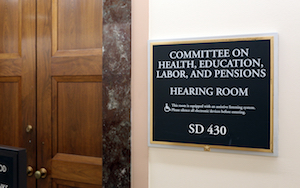Building off the SECURE 2.0 Act and taking a page out of the “behavioral finance playbook,” two influential senators introduced bipartisan legislation to establish an automatic reenrollment safe harbor. 
SECURE 2.0 soon will require new 401(k) and 403(b) plans to automatically enroll participants in their respective plans upon becoming eligible (the employee may opt out of coverage). The initial automatic enrollment amount must be at least 3% but not more than 10%. Each year thereafter that amount is increased by 1% until it reaches at least 10%, but not more than 15%. An exception is provided for small businesses, new businesses, church plans and governmental plans.
The Bill
The Auto Reenroll Act of 2023 (S. 2517) was introduced July 26 by Sens. Tim Kaine (D-VA) and Bill Cassidy, M.D. (R-LA) and referred to the Senate Health, Education, Labor and Pensions (HELP) Committee, on which both members serve. Cassidy also is the ranking member on the committee, meaning he is the top Republican serving on it.
The legislation also will likely be referred to the Senate Finance Committee—which has jurisdiction over matters involving the Internal Revenue Code (IRC)—on which Cassidy also serves.
The idea behind the legislation is to help nudge American workers into taking advantage of their available retirement plans and full employer match. While most larger plans have implemented auto-enrollment, some employees still choose to not participate in their employer's retirement plan or take advantage of the full employer match when starting out and making entry level wages. However, after opting out, many forget to join or increase their contribution as they move up in income, leaving significant money on the table.
To support the objective of the legislation, the senators cite data from the Bureau of Labor Statistics and Vanguard’s “How America Saves” showing that only 75% of private sector workers who have access to employer-sponsored retirement plans participate and one-third of employees are not taking advantage of their full employer matching contribution.
Plans Permitted to Sweep
To remedy the situation, the legislation would amend safe harbors in ERISA and IRC to permit plan sponsors to reenroll non-participants at least once every three years (but not less than one year), unless the individual affirmatively opts out again.
Plans would be permitted to sweep, as a group, everyone who meets the requirements for reenrollment, rather than on each employee’s enrollment date, and need only provide this reenrollment opportunity to those who are not participating in the plan at all.
Weighing in
“With over half of all Americans not on track for retirement and other safety nets like Social Security on track to go insolvent, we are in a retirement crisis,” Sen. Cassidy said in a statement. “Auto-reenrollment puts workers in the better position to prepare for retirement while staying in control of their financial decisions.”
“Many Americans have the option to enroll in employer-sponsored retirement plans, but they do not take advantage of this benefit and miss out on critical retirement contributions from their employers,” added Senator Kaine. “I’m proud to introduce this bipartisan bill to help more Americans take advantage of the retirement benefits offered to them and be on better financial footing.”
It appears that Sens. Kaine and Cassidy have a good working relationship. Earlier this year, they teamed up on legislation to help seniors better understand their claiming options for Social Security.
Full text of the Auto Reenroll Act can be found here.
- Log in to post comments
